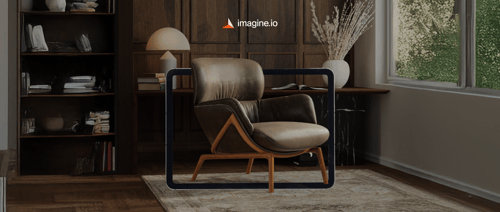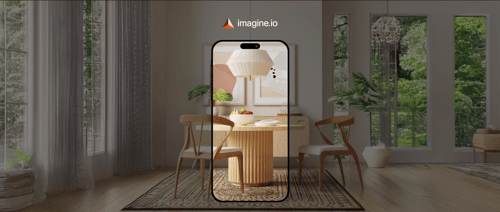What if you could make every merchandising decision faster, smarter—and prove the ROI before your next quarterly meeting? That’s exactly what 3D automation empowers you to do.
If you're in a leadership role—VP of Merchandising, Creative Director, or driving eCommerce innovation—this isn’t just another digital upgrade. It's a strategic pivot with real financial impact. Traditional merchandising workflows are manual, slow, and cost-heavy. They burn time, budgets, and bandwidth.
3D automation flips that script. It replaces guesswork with data, delays with speed, and expensive setups with scalable solutions. In this blog, we’ll break down how shifting to 3D automation delivers measurable cost savings—and why now is the ideal time to lead that change.
Get the latest updates straight to your inbox.
By clicking sign up you'll receive occasional emails from imagine.io. You always have the choice to unsubscribe within every email you receive.
1. Slashing Production Costs Across the Visual Pipeline
In traditional merchandising, every visual decision comes with a price tag: product photoshoots, set construction, props, lighting, photography crews, image editing, and post-production. Multiply that by dozens (or hundreds) of SKUs—and it becomes a serious line item.
3D automation cuts those costs dramatically. Here's how:
- You no longer need physical samples or real-world sets.
- One digital asset can generate endless visual outputs—angles, color variants, room setups, and seasonal themes.
- You can test multiple merchandising options without spending a dime on physical execution.
Instead of producing 10 room setups physically, your team can render 100 variations digitally—instantly.
2. Accelerating Time-to-Market and Reducing Opportunity Costs
Speed matters in retail. Missing a trend cycle or delaying a launch by even a week can mean lost revenue and missed shelf presence. With traditional merchandising, asset creation often takes 4–6 weeks per product line. With 3D automation, that timeline compresses to days.
- You don’t wait for product samples to arrive.
- You don’t wait for studio availability.
- You don’t reschedule due to weather, shipping delays, or broken props.
This translates to faster merchandising decisions, earlier campaign rollouts, and quicker response to market feedback.
3. Minimizing Rework and Approval Delays

Revisions can kill momentum. Whether it's a change in lighting, a new background, or an update to product color, each round of changes in traditional workflows can add days (if not weeks) and cost you extra each time. With 3D, edits are non-destructive, versionable, and efficient.
- Want a new color on the wall? Click.
- Need a bird’s-eye view instead of a side profile? Click.
- Switch a sofa from charcoal to beige? Click.
You’re not calling back the photographer or rebuilding a set. You’re simply updating the asset in your 3D library.
4. Optimizing Space Planning Without Physical Store Trials
Visual merchandisers often rely on mockups or test stores to plan layouts, which involve logistics, labor, and real estate. With 3D layout tools, you can design full showroom setups or shelf plans digitally.
More importantly, you can simulate shopper flows, lighting impacts, and visual sightlines without lifting a single product. This leads to smarter decisions without renting space or consuming manpower.
Bonus: These digital layouts can be repurposed across eCommerce, AR experiences, and internal training—giving you more ROI from one piece of work.
5. Scaling Personalization at Zero Marginal Cost
Personalization is the future of merchandising—but traditionally, it comes at a high price. Each unique layout, colorway, or shopper profile meant a separate visual asset. Not anymore. With 3D automation:
- You can personalize visuals for different geographies or store sizes.
- You can A/B test different merchandising options without duplicating creative efforts.
- You can target individual buyer preferences at scale using AI-generated outputs.
6. Improving Collaboration Across Teams and Reducing Silos

Let’s be honest—marketing, merchandising, and creative teams often work in silos. Each round of back-and-forth costs time and productivity. With a centralized 3D platform like imagine.io:
- Everyone collaborates in real-time using the same digital assets.
- There’s less back-and-forth over email and fewer miscommunications.
- Teams can visualize changes before approving, reducing friction.
This doesn’t just save money—it builds stronger internal workflows that scale.
7. Better Forecasting and Smarter Budget Allocation
Lastly, 3D automation brings a new level of predictability to merchandising budgets. You know exactly how much time and cost is involved in visual production. No hidden studio fees. No last-minute re-shoots. It allows higher management to:
- Forecast costs with greater precision
- Avoid overproduction of samples or collateral
- Reallocate savings toward strategic growth areas—like digital expansion or AI personalization
Final Thoughts: 3D Merchandising isn’t Just a Trend
Merchandising is evolving, and the brands that embrace 3D automation early are doing more than staying current—they’re getting ahead. Whether you're scaling your operations, entering new markets, or streamlining internal processes, 3D isn’t just the future—it’s the smartest decision you can make today.
Imagine your merchandising team delivering faster, smarter, and at half the cost—while still meeting the creative bar your brand is known for. If you’re ready to stop wasting time and money on outdated visual workflows, now’s the time to act. Want to see how 3D automation can cut costs across your merchandising workflow? Book a demo now and see what’s possible.


.gif?width=1296&height=1296&name=Untitled%20design%20(8).gif)




.png?width=500&name=How%20to%20Add%20a%203D%20Product%20Configurator%20to%20Your%20WordPress%20Website%20(Complete%20B2B%20Guide).png)
















%20(1).png?width=500&name=Why%20Exploded%20Mattress%20Views%20Matter%20(And%20How%20to%20Generate%20Them)%20(1).png)
.png?width=500&name=Best%20Shopify%20Product%20Configurator_%20How%20to%20Choose%20the%20Right%20One%20(2).png)
.png?width=500&name=Why%20Exploded%20Mattress%20Views%20Matter%20(And%20How%20to%20Generate%20Them).png)



.png?width=500&name=Best%20Shopify%20Product%20Configurator_%20How%20to%20Choose%20the%20Right%20One%20(1).png)







.png?width=500&name=How%203D%20Rendering%20Can%20Make%20or%20Break%20Your%20Industrial%20Design%20Pitch%20(1).png)








%20with%20Digital%20Twins%20and%203D%20Visualization.png?width=500&name=Optimizing%20Your%20Digital%20Asset%20Management%20(DAM)%20with%20Digital%20Twins%20and%203D%20Visualization.png)




.png?width=500&name=Styling%20Home%20Decor%20for%202025_%20From%20Global%20Influences%20to%20Playful%20Personalization%20(1).png)
